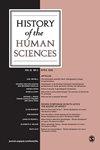威廉·谢尔登、阿尔道斯·赫胥黎和达灵顿的联系:身体类型计划为乌托邦未来提供了一条新的道路
IF 0.5
2区 历史学
Q2 HISTORY & PHILOSOPHY OF SCIENCE
引用次数: 0
摘要
当萧伯纳将达灵顿庄园描述为“乡村沙龙”时,他指的是在社区生活和乡村改革的大氛围中,围绕心理学、神秘主义和灵性的思想、对话和实验的大漩涡。由于对工业化的影响和第一次世界大战的破坏不再抱幻想,美国铁路女继承人多萝西·惠特尼·埃尔赫斯特和她的第二任丈夫伦纳德·埃尔赫斯特于1925年购买了德文郡的大片庄园,并开始鼓励定期访问,并从两次世界大战之间著名的英国知识分子(如奥尔德斯·赫胥黎和杰拉尔德·希尔德)那里获得社会和精神上的建议。20世纪30年代,随着庄园活动的扩大,多萝西邀请了来访的美国宪法心理学家威廉·谢尔登(William Sheldon)来帮助评估达灵顿实验学校的孩子们的健康状况,并提出建议。谢尔顿的“普罗米修斯心理学”和“躯体分型”身体分类系统为达灵顿群体提供了一种社会、精神和“科学”的选择,以取代弗洛伊德对心灵的理解。几十年后,像赫胥黎这样的访客,依靠谢尔顿的身体类型系统,在帕拉岛(在他的最后一部小说《岛》中)塑造了一种乌托邦式的教育,在那里,人们可能生活在非物质的合作和谐中。达林顿用谢尔顿的普罗米修斯心理学来支持进步教育的乌托邦观点,这种观点的吸引力就像几十年后帕拉的乌托邦野心一样短暂。然而,在接下来的几年里,谢尔顿的观点继续在体育教育家和运动科学家中找到了听众,他们认为身体类型是评估人才识别和未来运动成功的有用指南。本文章由计算机程序翻译,如有差异,请以英文原文为准。
William Sheldon, Aldous Huxley, and the Dartington connection: Body typing schemes offer a new path to a utopian future
When George Bernard Shaw described Dartington Hall as a ‘salon in the countryside’, he was referring to the maelstrom of ideas, conversations, and experimentation around psychology, mysticism, and spirituality within the estate's larger ethos of community living and rural reform. Disenchanted with the effects of industrialization and the ravages of the First World War, American railway heiress Dorothy Whitney Elmhirst and her second husband, Leonard Elmhirst, purchased the extensive Devonshire estate in 1925 and began to encourage regular visits and social and spiritual advice from prominent British interwar intellectuals such as Aldous Huxley and Gerald Heard. As the estate's activities expanded during the 1930s, Dorothy enlisted the help of visiting American constitutional psychologist William Sheldon to assess and advise upon the well-being of children attending Dartington's experimental school. Sheldon's ‘Promethean Psychology’ and ‘Somatotyping’ body classification system offered the Dartington group, a social, spiritual, and ‘scientific’ alternative to Freudian understandings of the mind. Visitors such as Huxley, decades later, relied on Sheldon's somatotyping system to fashion a utopian education in Pala (in his last novel, Island) where the population might live in nonmaterialistic cooperative harmony. Dartington's attraction to the use of Sheldon's Promethean psychology in supporting a utopian view of progressive education was as short-lived as were Pala's utopian ambitions decades later. In years to come, however, elements of Sheldon's views continued to find an audience among physical educators and sports scientists, who saw in somatotypes a useful guide for assessing talent identification and future sporting success.
求助全文
通过发布文献求助,成功后即可免费获取论文全文。
去求助
来源期刊

History of the Human Sciences
综合性期刊-科学史与科学哲学
CiteScore
1.60
自引率
11.10%
发文量
31
审稿时长
>12 weeks
期刊介绍:
History of the Human Sciences aims to expand our understanding of the human world through a broad interdisciplinary approach. The journal will bring you critical articles from sociology, psychology, anthropology and politics, and link their interests with those of philosophy, literary criticism, art history, linguistics, psychoanalysis, aesthetics and law.
 求助内容:
求助内容: 应助结果提醒方式:
应助结果提醒方式:


